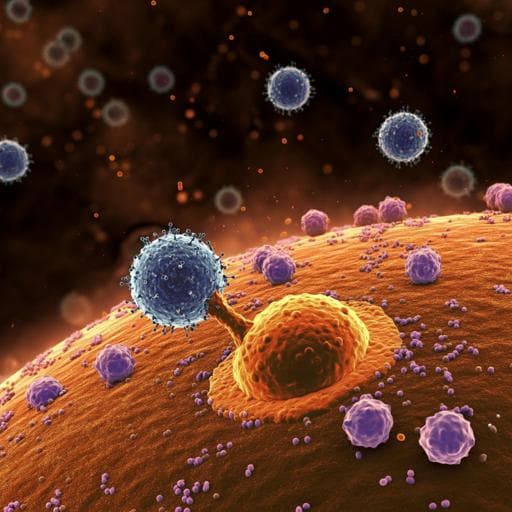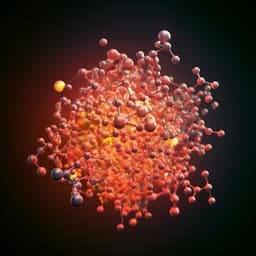
Medicine and Health
Environmental signals rather than layered ontogeny imprint the function of type 2 conventional dendritic cells in young and adult mice
N. E. Papaioannou, N. Salei, et al.
Discover how researchers, including Nikos E. Papaioannou and Barbara U. Schraml, reveal that conventional dendritic cells (cDC) in early life, despite being distinct from adults, are functionally competent in activating T cells. This groundbreaking study uncovers the dual hematopoietic origin and unique development waves of cDC2 during immune maturation, highlighting their potential in boosting early life immunity.
~3 min • Beginner • English
Introduction
The study addresses why conventional dendritic cells (cDC) in early life exhibit different functional properties compared to adults and whether these differences arise from ontogeny or environmental imprinting. Neonates display dampened immune responses, necessary for tolerance to commensals and environmental antigens, but increasing infection susceptibility. cDCs are potent activators of naive T cells; however, neonatal cDCs are fewer, express lower MHCII and costimulatory molecules, and often show Th2-biased responses. The cDC compartment contains cDC1 and cDC2 with distinct functions. While neonatal murine spleen is dominated by cDC1 and adults by cDC2, subset distribution alone does not explain early-life Th2 bias. The authors hypothesize that age-specific environmental signals rather than layered ontogeny determine functional imprinting of cDC2 and aim to dissect the developmental origins and functional capacities of early-life cDC2 versus adults.
Literature Review
Prior work shows neonatal cDCs in mice and humans have lower basal MHCII and costimulatory molecules and reduced IL-12p70 production, contributing to Th2 bias. Expansion with FLT3L can improve neonatal immunity. cDC1 primarily drive Th1/CD8+ responses via IL-12/IFN-γ, whereas cDC2 activate CD4+ T cells and can induce Th2/Th17/Tfh. Neonatal cDC1 show reduced IFN-α responsiveness and altered cytokine production. Few studies focused on cDC2 in early life; lung cDC2 exhibit lower costimulation yet can promote allergy and some CD8+ T-cell proliferation. Hematopoietic development occurs in waves; yolk sac progenitors seed tissues early, while definitive HSCs later sustain hematopoiesis. Adult cDCs arise from CDPs and pre-cDCs, with Clec9a-driven fate mapping marking cDC lineage. The contribution of lymphoid progenitors (e.g., CLPs) to cDCs has been suggested under certain conditions, but their role at steady state in early life remained unclear.
Methodology
- Mouse models and fate mapping: Used Clec9a-cre Rosa26-tdTomato/YFP mice to trace cDC lineage. Compared heterozygous and homozygous cre and different reporters to control labeling efficiency. Assessed cDC subsets by flow cytometry across developmental timepoints from embryonic day 16 to adulthood.
- Progenitor analyses: Identified DNGR-1 (Clec9a) expression in early-life MDPs, CDPs, and pre-cDCs in bone marrow and spleen by flow cytometry. Tested labeling completion in bone marrow versus periphery and TOMATO stability in culture.
- Lineage contributions: FLT3L-deficient mice to confirm FLT3L dependence. Yolk sac fate mapping via Csf1r-Mer-iCre-Mer RosaYFP pulsed at E8.5; Myb−/− embryos to test definitive hematopoiesis dependence. Lymphoid contribution via Rag1cre RosaYFP and Il7rcre RosaRFP fate mapping across ages. Cxcr4creER Rosa mTmG pulsed at E12.5 to trace fetal liver HSC-derived contributions.
- Transcriptomics: Bulk RNA-seq of sorted TOM+ cDC2 and TOM− DC2 from postnatal day ~8 and TOM+ adult cDC2; DESeq2 analysis, GSEA. scRNA-seq (10X Genomics) of MHCII+ splenic cells from PND9, excluding B cells and macrophages; Seurat clustering, integration of Tomato/unrecombined Rosa reads for in silico fate assignment; Palantir trajectory analysis. Rorc-eGFP reporter and Rorc-cre RosaRFP fate mapping to characterize RORγt+ DC2.
- Functional assays in vitro: Sorted cDC2 from young (2–2.5 weeks) and adult mice, OVA323–339 peptide pulsing; co-culture with naive adult OT-II T cells under Th0, Th1, Th17, and Treg polarizing conditions; assessed T-cell proliferation (CTV dilution), intracellular cytokines (IFN-γ, IL-17A), Foxp3, and secreted cytokines. Subset analyses of ESAMhigh/ESAMlow cDC2.
- Antigen uptake: Phagocytosis of fluorescent latex beads ± cytochalasin D.
- Cytokine sensing and production: Surface PD-L1 and CD38 profiling with age and in Ifnar−/− adults. PRR expression from RNA-seq. CpG-B stimulation of sorted cDC2 with measurement of IL-6, IL-12p40, TNF-α, IL-10, IL-27.
- In vivo targeting: Targeted antigen delivery to cDC2 via anti-DCIR2-OVA injection ± CpG-B adjuvant in young and adult mice; ex vivo co-culture of sorted DC subsets with OT-II T cells to assess proliferation and differentiation.
- Microscopy: Immunofluorescence localization of TOM+ and TOM− DC2 in spleen white pulp.
- Statistics: t-tests, paired t-tests, one-way ANOVA; RNA-seq analyses with DESeq2 and GSEA.
Key Findings
- Early-life cDC2 ontogeny and dynamics:
- cDCs detectable in spleen from E16; CD11b+ cDC2 frequency rises with age; ESAMhigh cDC2 proportion reaches adult levels by 2–3 weeks.
- Fate mapping with Clec9a-cre RosaTOM: adult cDC2 are ~93% TOM+ (mean ± SD 93 ± 1.28%), whereas neonatal (PND7) cDC2 are ~20.6 ± 4.48% TOM+, increasing to ~86 ± 1.4% by 4 weeks, indicating early-life TOM− DC2 wave.
- FLT3L is required for early-life cDC1 and cDC2 development (reduced in Flt3l−/−).
- No yolk sac contribution to cDCs: Csf1r-Mer-iCre-Mer pulsed at E8.5 labeled macrophages/Kupffer cells but not cDCs; cDCs reduced in Myb−/− embryos at E16.5, indicating dependence on definitive hematopoiesis.
- Lymphoid contribution in early life: Rag1cre fate labeling in cDC2 at PND2–3 (29 ± 5.30%) and PND7–9 (13.43 ± 3.16%), but negligible in adult; Il7rcre RFP strongly labeled neonatal cDC2. Cxcr4creER pulsing at E12.5 labeled fetal liver HSC-derived cDCs at E18.5.
- Phenotype and transcription:
- TOM+ cDC2 and TOM− DC2 at 1 week share similar surface markers (CLEC4A4, CD172a, ESAM, CD26, MHCII, CD80) and localization in white pulp.
- Bulk RNA-seq shows age as primary variance driver; only 167 DE genes between TOM+ and TOM− in young, with TOM+ enriched for cell cycle genes; TOM− enriched for some ILC-associated genes and a small RORγt+ fraction.
- scRNA-seq identifies cDC2 clusters resembling ESAMhigh (cluster 0) and ESAMlow (cluster 3); TOM+ and TOM− cells evenly distributed across cDC2 clusters; a unique early-life Rorc-expressing cDC2-like cluster (cluster 11), predominantly TOM− and transient with age.
- Age-imprinted signaling and receptors:
- Adults’ cDC2 enriched for IFN-γ, TNF-α, IL-2, and IFN-α response signatures; higher PD-L1 (Cd274) and CD38, both reduced in Ifnar−/− adults.
- PRR expression differs with age: adults higher in Clec7a (Dectin-1), Tlr7, Tlr5; young higher in Clec4n (Dectin-2), Tlr4, Tlr2; Tlr9 comparable.
- Young cDC2 express more Lgals3, Il6ra, Lgals1, Sema4a (supporting Th17/Treg); adults higher in costimulators Cd80, Cd40, Cd274, Tnfsf4 and Bmp2 (which can suppress Th17).
- Functional competence and T-cell polarization:
- Antigen uptake via phagocytosis similar across young TOM+/TOM− and adult cDC2; all process OVA and induce OT-II proliferation comparably.
- Under in vitro polarization, young TOM+ and TOM− cDC2 induce similar T-cell proliferation as adult cDC2 but promote more Th17 (approximately twofold higher IL-17A) and more Treg (higher Foxp3+) differentiation; no intrinsic Th2 bias observed in splenic cDC2.
- ESAMhigh and ESAMlow subsets from young mice show higher Th17 induction than adult counterparts; ESAMhigh young cDC2 also enhance Treg versus adult ESAMhigh.
- CpG-B stimulation: young TOM− DC2 secrete more IL-6, IL-12p40, TNF-α than adult cDC2; both young TOM+ and TOM− produce more IL-10 and IL-27 than adults.
- In vivo DCIR2-OVA targeting + CpG-B: young TOM+ and TOM− cDC2 induce comparable OT-II proliferation to adults but higher T-cell TNF-α; TOM− DC2 elicit higher IFN-γ than adult cDC2 (trend also for TOM+), indicating stronger Th1 differentiation in young.
- Germ-free vs SPF adults did not recapitulate neonatal cDC2 phenotype/function, suggesting factors beyond simple microbial load.
- Overall conclusion: cDC2 develop in waves with an early lymphoid-derived contribution, but ontogeny minimally affects function; age-dependent environmental cytokines imprint transcription and function, shaping PRR expression, cytokine secretion, and T-cell polarization.
Discussion
The findings demonstrate layered development of cDC2, with an early-life TOM− wave likely arising from HSC-derived lymphoid-restricted progenitors, which is gradually replaced by TOM+ cDC2 from Clec9a-expressing myeloid DC progenitors. Despite distinct origins, early-life TOM+ and TOM− cDC2 are phenotypically and transcriptionally nearly identical and function equivalently in antigen uptake, processing, and T-cell activation. The largest differences between early-life and adult cDC2 are driven by age-specific environmental cytokine exposure (e.g., type I/II interferons, TNF-α, IL-2), which imprints gene expression (including PRRs and costimulatory molecules) and functional outputs. Early-life cDC2 are capable of inducing robust T-cell responses, skewing towards Th17 and Treg in vitro, and enhanced Th1/TNF-α responses upon CpG-B–adjuvanted antigen targeting in vivo. These data argue against functional immaturity of neonatal splenic cDC2 and instead support age-tailored vaccine strategies that leverage neonatal cDC2 properties. Site-specific cues (e.g., lung IL-33/OX40L axis) and weaning-associated cytokine changes may further shape organ- and age-specific cDC2 functions.
Conclusion
This work shows that splenic cDC2 in mice develop in sequential waves, with a transient early-life contribution from lymphoid lineage progenitors, but that developmental origin does not determine function. Instead, distinct cytokine milieus in early versus adult life imprint cDC2 transcriptional programs, PRR repertoires, and costimulatory/cytokine outputs, thereby shaping their capacity to polarize T cells. Early-life cDC2 are fully competent antigen-presenting cells that can promote Th1, Th17, and Treg responses, highlighting their potential as targets to enhance vaccination and protective immunity in infancy. Future research should: (1) dissect specific cytokine and signaling pathways imprinting neonatal cDC2 (including roles of IFN-I/II, TNF-α, IL-27), (2) evaluate additional adjuvants and PRR ligands that optimally exploit early-life cDC2 bias, (3) map fetal-to-neonatal cDC2 transitions at single-cell and epigenetic levels, (4) explore the impact of microbiota and the weaning reaction on cDC2 programming, and (5) translate findings to human neonatal cDC2.
Limitations
- The study is conducted in mice, primarily focusing on splenic cDC2; extrapolation to humans and to other tissues (e.g., lung, intestine) requires caution.
- While multiple lineage-tracing models were used, precise identification of the exact lymphoid progenitor(s) giving rise to TOM− DC2 was not resolved.
- Functional assays mainly assessed responses to OVA and CpG-B; other antigens/adjuvants and PRR pathways were not systematically tested.
- The unique early-life RORγt+ DC2-like cluster’s functional role remains undefined and appears transient.
- Although germ-free comparisons were included, comprehensive dissection of microbiota-derived versus endogenous cytokine contributions across developmental stages was not performed.
Related Publications
Explore these studies to deepen your understanding of the subject.







